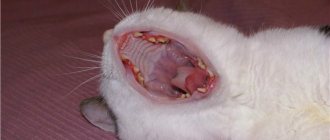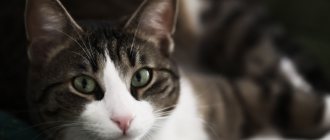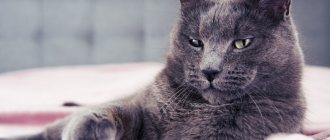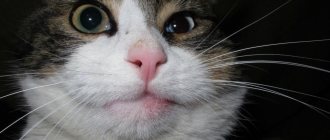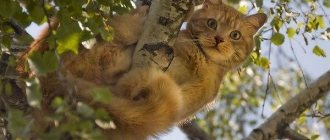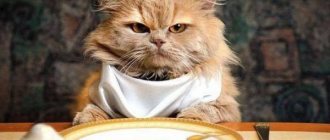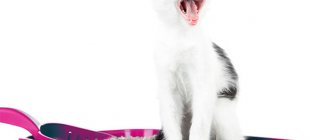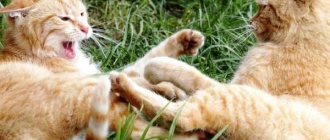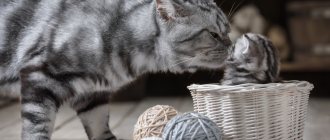Diarrhea in a cat causes concern not only for the pet itself, but also for its owner. It is easy to recognize the problem by frequent bowel movements, unusual color and consistency of feces, and a strange smell. There are many reasons for this condition; only a veterinarian can make an accurate diagnosis after examination and collection of tests.
Why do cats have diarrhea from dry food?
Each cat has its own characteristics, and while some cats can tolerate all foods, for others, switching to a new dry food can cause intestinal disorders and diarrhea. Let's look at the reasons why cats may develop diarrhea from dry food:
- Dry food may not be suitable for your cat's age; you should read the instructions on the packaging.
- Individual intolerance. Dry food may contain substances to which the cat is allergic.
- Overeating often leads to disruption of the digestive tract.
- Expired dry food. Expired products develop fungi that cause intoxication and diarrhea in cats.
Loose stools can also occur from habitual dry food that has been consumed for a long time. This can be facilitated by:
Dry food is very convenient to use. I poured it in and that’s it. No need to waste time cooking or cutting meat or fish. In addition, dry food is developed taking into account the characteristics of each animal; it contains vitamins and minerals necessary for normal life. Dry food, especially economy class, has negative aspects:
- They contain a lot of plant protein, which is poorly digested, thereby the cat’s body does not receive the proper amount of amino acids - a breakdown product of protein foods.
- Too much carbohydrate content is harmful for cats, since their body does not contain the necessary enzymes to break them down. The result of such a diet is obesity.
- Dry food retains little moisture, which leads to insufficient urine production, an increase in salt concentration, and this is fraught with inflammatory diseases of the urinary system and urolithiasis.
- Ready-made foods are supplemented with various chemicals to enhance their smell and taste. These substances are very harmful to the health of cats.
- They replace meat with cheap offal, which cannot provide the body with the required amount of protein.
So, economy class dry food contains many chemicals and vegetable protein, which are the culprits of allergic reactions, and allergies can cause loose stools in a cat, as well as itchy skin, baldness and much more. Regular consumption of such food significantly shortens the animal's life and worsens its health.
What should the stool look like?
Cats evolved in the steppe, arid climates of Africa and the Middle East. There's little water there. The cat's body has adapted to save water: cats can limit themselves only to the liquid that they receive from their prey. Therefore, they do not sweat and do not suffer from rapid breathing in the heat, like dogs. And that's why their urine is very dense. The cat's body tries to waste as little fluid as possible. Because of this, cat feces are very hard in their natural environment. It looks more like pellets: whitish or with a yellow tint, crumbly, with an admixture of cat hairs or prey hairs.
This is what normal cat poop looks like
The fewer ingredients a cat digests, the more often it goes to the litter box. Industrial feed contains many ingredients with low nutritional value. Most of the ingredients are poorly absorbed by cats. Therefore, cats that eat dry food go to the litter box more often. Their stool is bulky, loose, and has a pungent odor.
How to find out why a cat has diarrhea?
To determine the cause of loose stools in cats, you need to visit a veterinary clinic.
At the first examination, the veterinarian will examine the animal to identify external signs of illness, and will also ask a number of questions about the condition of the animal, the duration of symptoms, the frequency and nature of bowel movements. That is, are there impurities in the stool, the smell, what color is the stool. In addition to an external examination and clarification of symptoms, the cat will need to undergo a study consisting of blood, feces, and urine tests. In addition to laboratory tests, it will be necessary to examine internal organs and systems using ultrasound, x-rays, computed tomography, endoscopy, and colonoscopy. First of all, the digestive organs – the intestines and stomach – are examined. It is also important to find out the condition of the kidneys and endocrine system, for which tests are carried out for hormone levels. Be sure to conduct tests for the presence of helminths, various types of infections, allergic reactions, and food tolerance.
Determining the cause of diarrhea by the color and smell of stool
Many diseases that cause diarrhea in cats have characteristic features.
Prolonged diarrhea does not go away without leaving a trace. The main danger is dehydration.
Along with liquid feces, the body loses a lot of fluid, the lack of which can lead to irreversible consequences. As a result of dehydration, the blood circulation process is disrupted, oxygen starvation occurs, which poses a danger to the brain, heart, blood vessels, digestive, and immune systems. The body's resistance drops sharply. In addition, with moisture, the cat loses weight, this poses a mortal threat, especially for kittens. In addition, with loose stools, the supply of minerals and vitamins is lost, which disrupts the functioning of the entire body and all organs. Therefore, treatment of this disease cannot be delayed.
Stool standards for cats
Normally, a small kitten's feces are soft, have a characteristic odor, and are shaped like a light brown sausage.
After changing your diet and adding new foods to your diet, the consistency and color of your stool may change slightly, which is also not considered a deviation. Liquid or semi-liquid stool is a characteristic symptom indicating problems with the functioning of the digestive system. If diarrhea bothers you for one day, but then the condition returns to normal, there is most likely no reason to worry. When a kitten has diarrhea for 2-3 days, while the belly is swollen, the baby is constantly ill and does not eat anything, it is necessary to establish the causes of the pathology as soon as possible, so a visit to the veterinarian is indispensable.
Symptoms of diarrhea in cats
In addition to loose stool and frequent urge to defecate, symptoms of diarrhea include:
- lack of appetite;
- lethargy;
- drowsiness;
- the shine and smoothness of the coat is lost, sometimes a change in color can be observed;
- noticeable weight loss;
- the appearance of purulent discharge from the ears and eyes;
- dilated pupils;
- sticky and dirty fur in the anal area;
- a pain syndrome appears in the abdominal area, which can be detected by touching or stroking this area.
Feline diarrhea (diarrhea) is a rather unpleasant intestinal disorder, well known to every self-respecting cat lover. Our little brothers also often suffer from this painful condition, no less than people. The main symptom of diarrhea that the owner of the animal can notice is more frequent bowel movements, the stool is very liquid and its quantity is much less than usual. Diarrhea may be black or even red, this indicates that internal bleeding has begun in the stomach. Other external symptoms of an upset stomach may be: lack of appetite, nausea, abdominal pain, and, as a result, atypical behavior of your pet. A painful pathological condition will not only cause stress in your pet, but will also increase the load on the internal organs. The most effective treatment in such a situation is surgical treatment, which began immediately after symptoms were identified.
Treatment depending on causes and symptoms
Considering the three reasons why a kitten may develop diarrhea (infections, changes in diet and worms), treatment procedures should be carried out based on ways to eliminate the three main problems. For this purpose, serums with antibodies against various infectious diseases are used. Antibiotics are used to suppress secondary microflora developing on the affected mucous membranes of the intestine.
These can also be probiotics that restore intestinal microflora, and anti-worm medications in the form of a suspension or tablets. Intestinal spasms are relieved with Papaverine, which also helps normalize peristalsis. Diarrhea causes dehydration. To prevent this, small pets may be given IVs. They are also used to relieve toxicosis and for feeding. If possible, drugs are administered intravenously, but given the situation, they are most often limited to subcutaneous administration.
After the first vomiting appears, the animal is stopped feeding. You should know that a kitten is a fragile creature, so not giving it food for too long is dangerous for its life. In this situation, 12 hours without food is the maximum you can do.
If your kitten has diarrhea and vomiting
Often, kittens are not fed properly, which in turn leads to diarrhea and vomiting. What to do in this situation? A sudden change of food, overeating - all this disrupts the processes of food absorption, and the kitten begins to suffer from diarrhea. You should not suddenly change the baby’s diet, you need to switch to new food slowly, slightly increasing the amount of a new product in the pet’s daily diet every day. If it is noticed that the kitten does not know how to eat in moderation, then you need to reduce the amount of serving. It is better to give food less, but more often.
Kittens are extremely inquisitive and the baby can easily eat some poisonous substance. Not only vomiting and diarrhea are provided. If measures to save the pet are not taken promptly, the small cat may not live to see the next day. Diarrhea and vomiting can also be caused by inflammatory diseases of the gastrointestinal tract.
What to do?
In any of the above cases, you should monitor the development of the situation. If it is clear that the kitten is getting worse every minute and there is no improvement, or other negative signs of the disease appear, then you need to rush to the veterinarian. If, despite diarrhea, the kitten feels quite satisfactory: he is cheerful and playful, then you can try to solve the problem on your own.
The first thing you will have to do is deny your baby access to food. When vomiting, time is sometimes the best medicine. Let the baby’s stomach recover and it is quite possible that the next day there will be no trace of the illness left. Please keep in mind that your pet should be given water regularly and preferably in sufficient quantities.
. After all, water is an additional opportunity to flush the stomach.
If your kitten has bloody diarrhea
Veterinarians have noted several main reasons that cause blood to appear during diarrhea in kittens:
- poor blood clotting;
- damaged intestine, anus;
- use of toxic substances such as rodent poison (warfarin);
- lower intestinal cancer and non-cancerous polyps;
- allergies or individual intolerance to the product;
- various types of infections and parasites.
Possible treatment.
Based on the research results, the veterinarian can recommend several methods that have a beneficial effect on the kitten’s condition:
- drugs that help normalize the functioning of the digestive tract;
- antibiotics if your baby gets a bacterial infection;
- anti-worm medications, if detected;
- drinking boiled water;
- change of diet.
If your kitten has diarrhea with mucus
If this symptom is present, the first thing to remember is whether the kitten has recently taken antiparasitic drugs. Usually, diarrhea with mucus in kittens is the body’s reaction to the dominance of parasites in the stomach. These may not even be worms, but the simplest forms:
- trichomoniasis;
- coccidosis;
- Giardia;
- isospores, etc.
If therapy aimed at cleansing the pet’s body took place not long ago, then the presence of mucus indicates a successful outcome of the treatment. For mucus is nothing more than the digested remains of dead parasites. Symptoms of this kind pass quickly; it usually takes several days to completely cleanse the body of unwanted neighbors.
But if mucous diarrhea in a kitten is accompanied by other negative symptoms: vomiting, loss of appetite, weakness, fever, then this is already a sign of inflammation of the lower intestine. And whatever disease causes the disorder and loose stools of the pet must be urgently taken to the veterinary clinic. By the way, if you take some animal feces with you as a sample, this will simplify the work of a specialist in making a diagnosis, and therefore speed up the treatment and recovery of the baby. Leave the health work to the doctor, and he will tell you what to do next to ensure that the kitten’s health returns to normal as quickly as possible.
If your kitten has diarrhea and won't eat anything
If this is a very small kitten who has recently begun to wean itself off mother’s milk and its body has not yet fully adapted to adult food, then diarrhea and refusal to eat are a standard occurrence. If the kitten is older, then this situation may arise from the fact that he may overeat. But you should know that this is only normal if the animal goes to the potty as usual.
The worst thing is when the baby's discharge almost never stops. This is a clear sign of illness. If you are concerned about your pet's health, you should consider its discharge. If the stool smells bad, is very liquid, and also has an unnatural color, then this is already a dangerous situation. If there is also blood in the feces, this is a signal to immediately call a doctor.
The worst case scenario is panleukopenia, known as “feline distemper.” This is a viral disease that is difficult to combat and progresses extremely quickly. Diarrhea and lack of desire to eat anything are one of the signs of this disease. But fortunately, there is a vaccine against panleukopenia.
If your kitten has diarrhea of an unusual color
Normal stool color ranges from several shades of brown, but if your kitten's stool takes on an unusual color, it's definitely a sign that shouldn't be ignored.
- For example, green diarrhea in a kitten is a sign that the baby’s stomach contains stale food contaminated with putrefactive microflora. Usually this phenomenon is accompanied by an elevated temperature of a small pet.
- Copious stools of a grayish color and with a specific, rancid odor are a clear sign of impaired digestion.
- Too light, white feces indicate problems with bile secretion and/or liver disease.
- Red diarrhea (blood streaks) – possible bleeding in one of the parts of the kitten’s gastrointestinal tract.
- Black, tarry stool is the same as with red diarrhea, a sign of possible hemorrhage in the digestive tract.
- Yellow diarrhea means that the kitten does not digest food well, and orange discharge is a reason to think about the health of the baby’s liver.
Causes of diarrhea
The stool of a healthy cat is similar to human feces: it is just as soft, slightly moist, and keeps its shape. The color range is from black-brown to light brown. The average cat, being healthy, walks mostly once or twice a day, provided it is regularly fed. As soon as the feces become too soft, mushy, lose their shape and spread across the surface of the floor or cat litter in streams of water, this is a sign of diarrhea. The most common cause is disruption of the gastrointestinal tract. A cat may eat expired or spoiled food, the quality of which the owner did not check in time. Along with food, food waste may come in that the cat’s stomach cannot digest. If you suddenly change the brand of cat food, and your pet’s digestive system has not yet adapted to the new composition of the food, the likelihood of diarrhea increases sharply.
Other causes of cat diarrhea may be an incorrect diet, motion sickness in transport, especially when the trip is long, or the influence of stressful situations (meeting with other animals, a fight, going to the veterinarian). In the latter case, the nervous system, which works to the limit, wears out greatly, and the consequences of overstrain cause disruption in the functioning of the gastrointestinal tract. All of the above causes of diarrhea are relatively harmless and easily eliminated, but they are much more serious if diarrhea is just a concomitant symptom of your pet’s illness.
The main diseases that cause diarrhea in cats:
The last 3 diseases on the list are very serious, for their treatment it is worth contacting a veterinarian; in such cases, you cannot do independent home treatment, it is simply not effective, during which time the cat’s health may deteriorate or death may occur. But don’t panic ahead of time; in most cases, diarrhea is just a digestive disorder that can be cured on your own. If recovery does not occur for a long time, you should contact a specialized animal clinic.
Nematodes (white roundworms) (Toxocara, hookworm, uncinarium)
Roundworms (nematodes) also infect the gastrointestinal tract of cats, and their favorite location is the small intestine. Unlike white tapeworms, round worms reproduce and live inside the cat for several generations.
They can fill the entire intestine, even to the point of developing obstruction. Nematodes do not always leave the cat's gastrointestinal tract along with feces. They secrete eggs, the presence of which can be easily determined in the laboratory.
If your cat's stool contains thread-like white worms that look like spaghetti and squirm and make circular movements, then these are most likely nematodes. The intestines are clogged with parasites, they become crowded, some of the individuals pass out along with the feces. There are also frequent cases of nematodes coming out with vomit.
Types of parasites
- Toxocaras are thin, long white worms (6-10 cm) with a sharp end. It most often affects kittens aged 1-3 months who eat invasive raw meat, rodents, flies, or become infected in utero. After digesting the food eaten, Toxocara larvae emerge from the eggs and move into the kitten’s lungs. After some time, the grown worm larvae irritate the walls of the lung, cough up and are swallowed again. Worms actively multiply in the small intestine of a kitten. When the intestines empty, the eggs come out and settle on the grass, where they are eaten by mice, livestock or insects. Toxocariasis is dangerous for both cats and humans. Worm eggs can be found on furniture, children's toys, and can also be carried by flies. When eggs are ingested in the body of a child or adult, the larva does not develop into an adult, but migrates to other organs and becomes encapsulated, which causes a number of ailments.
- Hookworms are smaller worms, 2-3 cm long. They feed on the blood of kittens and cats and can cause anemia and death in young animals. The location of hookworm is the small intestine. Kittens become infected with worm eggs through contact with sick animals, food and water. The larvae grow, injure the intestinal mucosa and cause swelling. When actively multiplying, hookworms can lead to complete blockage and obstruction of the intestine. Due to the massive accumulation, some of the worms die, which often leads to intoxication with decay products. Against the background of existing anemia, this process ends in the death of the kitten.
- Uncinaria are small white nematodes 1-1.5 cm in size. They cut through the mucous membrane of the small intestine and feed on blood. The life cycle is similar to hookworms. Life expectancy in a cat’s body is up to 2 years.
What do worms look like in cats?
Roundworms in cats are white with a yellowish tint. Visually, they are similar to thin fishing line or spaghetti pasta. They have a hard shell. The length of adult individuals ranges from 1 to 10 cm. The body is not segmented.
Signs of the disease
Common signs of increasing roundworm infestation include:
- poor appetite;
- a swollen, dense and painful abdomen in kittens (due to food refusal);
- weight loss;
- anemia, which is manifested by pallor of the mucous membranes;
- liquid cat feces (sometimes mixed with blood or white worms);
- vomiting of live helminths (with blockage);
- hyperthermia;
- dull, tousled fur.
- cough (during Toxocara migration).
Important! In severe stages of infestation, the intestinal walls may rupture and worms may escape into the abdominal cavity, which leads to internal bleeding and death of the cat.
Prevention and treatment of worms
Specific treatment of nematodes in kittens and cats is carried out using veterinary anthelmintics based on milbemycin, pyrantel, and moxidectin. But due to the widespread prevalence of mixed infestations (when round and tapeworms are found in one animal), veterinary companies produce broad-spectrum medications.
Anthelmintics contain 2-3 active components, one of them kills nematodes, and the second destroys cestodes. Examples of medications are given above.
The course of treatment for nematodes includes several stages:
- Getting rid of worms by taking medications 2-3 times, with an interval of 7-10 days (if there are not too many worms).
- Antitoxic therapy, which is aimed at removing decay products from dead worms in the intestines (injection solutions).
- Vitamin therapy.
- Gentle therapeutic nutrition.
If there is a complete blockage of worms and obstruction of the small intestine in a cat, veterinarians strongly recommend surgical treatment. The operation is abdominal and is performed under general anesthesia.
As measures to prevent the development of nematodes in cats and the safety of young animals, it is necessary:
- treat animals from external and internal parasites before mating;
- It is mandatory to carry out routine deworming of pregnant cats in the last third of pregnancy;
- Treat lactating cats for helminths 2-3 weeks after birth (carefully choose the drug);
- carry out preventive treatments for kittens starting from 3 weeks of age 2 weeks before vaccination;
- treat adult healthy pets for worms (regardless of the conditions of keeping and walking) 4 times a year, for fleas - monthly.
Every owner wants to see their cat healthy, well-groomed, affectionate and playful. However, showing excessive care and concern for their pet, owners often neglect the recommendations of doctors on preventive measures for deworming cats.
The reason is that many people mistakenly consider their home to be sterile. But by feeding your cat a tasty meat tablet against worms once a quarter, you can protect all family members from various ailments.
How and how to treat diarrhea in cats
Before starting any treatment, it is worth remembering exactly what you fed your cat the last 2-3 times. If the diet included raw liver or fish, too fatty meat or stale fermented milk products, most likely it was this food that disrupted the functioning of the gastrointestinal tract and caused diarrhea. It is necessary to stop feeding the animal these products and replace them with less heavy food, in other words, put the cat on a temporary diet. If the bowel movements are liquid, large in volume and incommensurate with the volume of food that you gave last time, there is overfeeding, possibly from the great love of the owner. You need to stop feeding so often and reduce the portions of food.
If the recommendations described above do not help, and the cat does not develop new symptoms, such as high fever, lethargy, or increased drowsiness, you need to start drug treatment. First, the patient needs to undergo a daily course of cleansing fasting; for a kitten, 12 hours is enough. Provide constant access to clean boiled water at room temperature. Give activated charcoal twice a day. Dosage calculation: one tablet per 10 kilograms of weight. If your pet belongs to miniature breeds (Himalayan cat, Toyger) that weigh 3-5 kilograms, you need to give half a tablet.
Dilute the tablet in boiled water, take the resulting mixture with any syringe without a needle and inject it into the animal’s open mouth. The most convenient way is to hold the cat with your knees, throw back his head and, fixing his chin, pour the solution between his teeth. Keep the head tilted back until he swallows the medicine. Chamomile or St. John's wort tea will be a good addition to charcoal tablets; it also disinfects the walls of the stomach and removes toxins.
After a hunger strike, you can carefully start feeding your cat food that is easily digestible. The main and available products are: boiled egg yolk, chicken meat and boiled rice. If your pet eats raw or cooked vegetables, you can give them. At any pet store you can purchase medicinal food with bifidobacteria and biologically active additives adapted to the age of the cat. After studying the annotation, the dosage, number of doses and duration of treatment will become clear.
How to help your pet with diarrhea
In a number of simple cases, first aid can be provided to a cat with loose stools:
- arrange a day of hunger strike for the animal (but it is necessary to give the animal drink, in abundance and in constant access!);
- offer your pet decoctions of oak bark, chamomile, rice or blueberries; you can also give your cat plain, clean water;
- to reduce intoxication after poisoning (if this fact is known for sure), give a barely pink solution of potassium permanganate (1 ml at a time);
- Sorbents, for example, activated carbon (1 tablet per 1 kg of body weight), can help with loose stools;
- starch, mixed with water to the consistency of a thick porridge, put into the cat’s mouth to consolidate loose stool;
- put your pet on a diet.
If these actions helped, the cat became noticeably better, the stool is no longer liquid - still, you should not suddenly return the pet to its usual diet too abruptly. The animal’s stomach and intestines have experienced stress, and they are not ready to immediately begin their activities with the same strength. Therefore, after the diet, you need to reintroduce the foods that the cat ate before the problem occurred very gradually. It is not recommended to give food rich in carbohydrates at first.
If the pet clearly does not recover after the measures taken, the cat still passes loose stools or feels noticeably worse , there is no need to think any more about what to do to help the pet at home. In this situation, only a doctor can cure the animal.
Treatment of diarrhea in kittens
If a kitten has diarrhea while switching to a different brand of food, or the kitten has just been acquired and you don’t know what it ate before, most likely the digestive system is adapting to the new food. Diarrhea should go away on its own, you need to observe the process of adaptation, do not expand the diet and do not change the feeding order. If the kitten is very small, up to 3-4 months, it is advisable to make the transition to another food gradually: systematically add the amount of new food to meals and reduce the share of old food, this algorithm will have the least impact on the physical health of the kitten. In other cases, the causes and treatment of diarrhea in kittens are similar to intestinal disorders in adult cats.
Visit the profile section of our forum or leave your opinion in the comments below. More opinions means more useful information, it will be useful to someone. If there are good and interesting videos on the topic of the article, write and I will insert them into this publication.
Such unpleasant moments are not uncommon these days, since pets can eat everything without understanding what is healthy and what is not. There are others, cats and kittens, which are discussed in detail in this article.
All methods of treatment and symptoms of a particular disease are presented, presented to familiarize yourself with the situation and are of an informational nature, because everyone should understand that only a veterinarian can accurately determine the problem and prescribe the necessary treatment for the animal with tablets or special injections and procedures.
My cat has diarrhea, what tests should I take?
If a cat has a persistent stomach disorder, then the animal’s feces must be submitted to the veterinary laboratory, and the attending physician must be informed of a complete list of the patient’s daily diet.
In some cases, in addition to the above, a general blood test of the cat may be prescribed.
The cat has white, marsh, mustard, yellow, green diarrhea: causes and treatment
Diarrhea (diarrhea) in a cat can be caused not only by poor quality food. The appearance of white and yellow hues in an animal’s stool indicates kidney disease; swamp and mustard stool indicate gastrointestinal diseases and internal bleeding; greenish stool indicates putrefactive processes affecting the intestines.
In any case, it is better to play it safe and visit a veterinary clinic with your pet.
The cat has red, brown, dark diarrhea, what to do and what to give at home
Loose stool in a cat that is reddish-brown or dark, almost black, is a sign of internal bleeding in the animal’s stomach or intestines. The symptom is quite serious and is unlikely to be eliminated at home. A four-legged pet needs emergency medical care!
The cat has diarrhea, but he is cheerful and cheerful
If a cat has diarrhea, but he is still cheerful and cheerful, this does not mean that he is healthy. It is necessary to observe the animal - whether the cat is hunched over when walking, whether its stomach is swollen, and how often it defecates. There are many nuances of deviation from the norm, and diarrhea may not be a simple malaise, but a symptom of a much more serious disease.
What to do if a cat has diarrhea with water and vomits bile, foam, blood in the stool and does not eat anything
These symptoms are signs of severe poisoning or diseases of the gallbladder, stomach, liver or intestines. To prevent the animal from dying, it must be urgently shown to specialists.
The cat has diarrhea and refusal to eat, drooling, what medications and tablets, Vetom and sea buckthorn suppositories, antibiotic treatment
Treating animals with any medications and tablets intended for humans, without the advice of a veterinarian, can only worsen the condition of a sick cat. This primarily applies to the mentioned sea buckthorn candles. For diarrhea, they are contraindicated as they have a laxative effect.
How to eliminate diarrhea in a cat using folk remedies
Diarrhea in a cat can cause dehydration, so the animal must be given plenty of fluids. For these purposes, people often use a weak pinkish solution of potassium permanganate, a decoction of pomegranate peel, as well as an infusion of herbs that have a binding effect - St. John's wort, yarrow or chamomile.
A cat has diarrhea and loose stools from dry food, what should I do?
Loose stool in a cat caused by eating dry food is a signal to change the diet. Try to purchase higher quality food and put the animal on a starvation diet for a while, giving only plenty of fluids.
The kitten has diarrhea, worms, no worms
One of the causes of diarrhea in a kitten is helminthic infestation. A large number of helminths causes toxicosis in the body, accompanied by diarrhea. The reasons that cause diarrhea in kittens that are not infected with worms are: - stressful situations associated with changes in the usual way of life;
Categories:
Why does a cat have diarrhea? When should you worry if you find loose stools? How to cure diarrhea at home?
Normally, adult cats defecate no more than 2 times a day. Feces are moistened, formed, have a soft consistency and a dark brown color.
Diarrhea or diarrhea is frequent bowel movements with increased water content in the stool.
Diarrhea is not an independent disease. This is a disruption of the normal functioning of the intestine, which accompanies many diseases and pathological conditions of both the intestine itself and other systems and organs of the body.
Acute diarrhea causes dehydration, which is life-threatening.
Chronic diarrhea leads to exhaustion and weakened immunity. With chronic diarrhea, food is poorly absorbed as a result of which the body experiences a deficiency of essential nutrients, vitamins and microelements.
The causes of diarrhea are varied. Stool disorders are accompanied by both mild food indigestion and serious diseases of the whole body or its individual organs.
Alimentary diarrhea
Associated with the animal’s nutrition, these include:
Infectious diarrhea
Diarrhea is accompanied by many infectious and invasive diseases:
- Bacterial infections
– colibacillosis, salmonellosis, etc. - Viral infections
– panleukopenia, leukemia, etc. - Invasive diseases
(caused by helminths and protozoa). With infections and infestations, in addition to diarrhea, general depression, fever, vomiting, and conjunctivitis (inflammation of the mucous membranes of the eyes) may be observed.
Dyspeptic diarrhea
They occur when there is a lack of digestive secretions necessary for digesting food. Such diarrhea is accompanied by diseases of the stomach, liver, and pancreas.
Neurogenic diarrhea
Occurs in stressful situations, under the influence of excitement or fear. Associated with disruption of the nervous regulation of intestinal motility by the central nervous system. Diarrhea due to nervousness occurs when a change of environment, moving, or the appearance of a new animal or person in the house.
Drug-induced diarrhea
Long-term use of antibiotics and other antibacterial drugs destroys the natural intestinal microflora, resulting in the development of dysbacteriosis.
Toxic diarrhea
Occurs due to poisoning with arsenic, mercury and other pesticides, toxic drugs. Often such poisoning in cats occurs when they eat poisoned mice or rats, or when they overdose on anthelmintic drugs.
Reasons for changes in stool
Changes in the color and consistency of feces in a kitten or adult cat are often associated with errors in nutrition. When eating unsuitable food, the load on the digestive organs increases. The stomach does not completely digest food, and the intestines cannot fully absorb it. The result is unformed feces in which mucous particles can be found.
Other common causes
Intestinal dysfunction can lead to a change in the color of stool, as a result of which food stagnates in the intestines.
But in addition to poor-quality food, the following diseases and disorders can affect the consistency of excrement:
- Intestinal dysfunction. Insufficient secretion of digestive juices and weak peristalsis contribute to stagnation and fermentation of eaten food in the body. Soon, pathogenic microflora begins to actively multiply, causing increased gas formation and flatulence. The cat's feces turn out to be green.
- Insufficient enzymatic activity of the pancreas. The consequence of this disorder is poor digestion of food, resulting in yellow feces remaining in the tray.
- Hepatitis. As the disease progresses, the functioning of not only the liver, but also the gallbladder is disrupted. As a result, the cat's feces become discolored, but the urine becomes dark brown.
- Internal hemorrhage. If the cat passed liquid black feces onto the tray, this means that bleeding has occurred in the stomach, or more precisely, in the upper section. When bright red blood is present in the stool, this indicates that damage has occurred in the intestine itself.
Orange dry feces often appear in pets when they eat food colored with dyes. If the stool is not soft, but hard, like a goat's, this means that the animal's diet does not have enough fluid. In this case, it is enough to adjust the menu and change the brand of food. If, even after changing the diet, the cat poops liquid or too dry, it is better not to hesitate to visit the veterinarian.
Treatment at home
The first thing to do is to find out and eliminate the cause
diseases.
Analyze all the latest events and try to determine the reason for the diarrhea. Perhaps you gave your cat some product of suspicious quality, sour milk, etc.
In any case, if diarrhea appears, give the cat activated charcoal at the rate of 1 tablet. per 10 kg of animal weight. Pre-crush the tablet and mix with a small amount of water.
The suspension can be poured using a bulb or a syringe without a needle. To do this, lift the cat's head and slowly pour the solution from the side of the mouth. Charcoal tablets can be given twice a day.
Chamomile decoction helps very well in treating digestive disorders. You can give it 10-20 grams depending on the size of the cat.
If you have recently treated your animal with antibiotics or other antibacterial agents, then the cause of diarrhea may be dysbacteriosis. In this case, you need to give the cat drugs that normalize the intestinal microflora - Vetom, Smecta, etc.
If you suspect infestation with worms, carry out deworming.
In more severe cases, if the general condition worsens, you should contact a veterinary clinic.
If your cat has been diagnosed with ulcerative colitis
This is a very serious disease for a pet when its gastrointestinal tract is infected with parasitic bacteria. But these are rare cases; most often, ulcerative colitis is a manifestation of food allergies. Then the veterinarian himself prescribes hypoallergenic food to the animal suffering from allergies, which is considered an excellent replacement for traditional food, in case of emergency.
It would not be amiss to say that if your cat is not prone to food allergies and eats everything, then continue in the same spirit to give her properly prepared, natural food, since it is a hundred times healthier than even the most selected and high-quality food. By including white chicken and meat porridge with vegetables in your mustachioed pet’s daily diet, you will thereby protect her from many diseases.
It is possible to buy red fish, well - boil it and give it to your cat, boiled beef liver along with green grass more often - and your cat will have neither dysbacteriosis nor problems with bowel movements, but only normal, daily stool without mucus and unpleasant odor.
How to determine intestinal pathology by stool analysis
| Sign | Characteristic | Possible reason |
| Consistency | Watery | rapid passage of food through the intestines (spastic colitis); impaired absorption of water (age-related degeneration of intestinal villi) |
| With mucus | inflammation of the intestines (colitis), including as a result of infectious diseases and helminthic infestations | |
| Oily, with a greasy sheen | enzyme deficiency due to enteritis or pancreatitis | |
| Pasty with bubbles | Imbalance of intestinal microflora - (many bacteria that produce gas) | |
| With blood | parasites; stomach and intestinal ulcers; foreign bodies; tumors. | |
| Color | black | bleeding in the upper gastrointestinal tract |
| with bright red streaks or lumps | bleeding from the lower gastrointestinal tract or anus | |
| light (up to pale yellow) | obstruction of bile flow (gallbladder and duct stones or tumor) | |
| yellow-green | too rapid passage of feces through the intestines; increased amount of pathogenic microflora in the colon. | |
| Frequency of bowel movements and amount of stool | often and in small portions | irritation of the rectum (parasites, spasms); rectal prolapse; stress factors |
| large quantities 3-4 times a day | enteritis; dysbacteriosis; enzymatic deficiency. |
If severe diarrhea continues for more than a day, there is blood in the stool, the cat is exhausted and there are signs of severe dehydration (fever, pale and dry mucous membranes, convulsions, lethargy), you should immediately consult a veterinarian. But some conditions accompanied by diarrhea can be corrected at home.
Ways to stop diarrhea in your pet “at home”
- Diet correction. When there were errors in the diet, you need to figure out which product caused the failure. If the cause of diarrhea is regular milk, then you should either refuse it or buy special lactase-free milk (sold in hypermarkets and intended for people, but it can be given to cats without fear). There is another option - fasting for 12 hours.
- Improvement of emotional background. Living in city apartments, in constant proximity to other cats, and the inability to go outside for months and behave according to natural cat instincts contributes to chronic and dangerous stress. One of the diseases that occurs due to nervousness is irritable bowel syndrome. It is accompanied by diarrhea and abdominal cramps: the cat behaves restlessly and often goes to the litter box. It is necessary to provide an adequate psychological atmosphere: touch the animal more often, stroke it, talk. This helps the cat feel welcome and loved.
A cat that lives in an apartment may become stressed and develop diarrhea.
- Deworming. If there is a suspicion of the presence of parasites (for example, after a bowel movement, white squirming “worms” came out of the intestine), you need to give your pet well-known antiparasitic drugs, such as Levamisole or Kanikquantel. As a rule, the dosage of the active substance in one tablet is sufficient to kill helminths. But if necessary, you can repeat the procedure again.
- Fortification. There are special vitamin complexes for cats. They can be used both to maintain the general tone of the body and in the complex treatment of gastrointestinal pathologies. Zinc, selenium, vitamins A and E, bioflavonoids, vitamin C, B12 and K improve the functioning of the immune system and help relieve inflammation in the intestines.
If your cat only eats dry food, add a vitamin complex to his food bowl.
